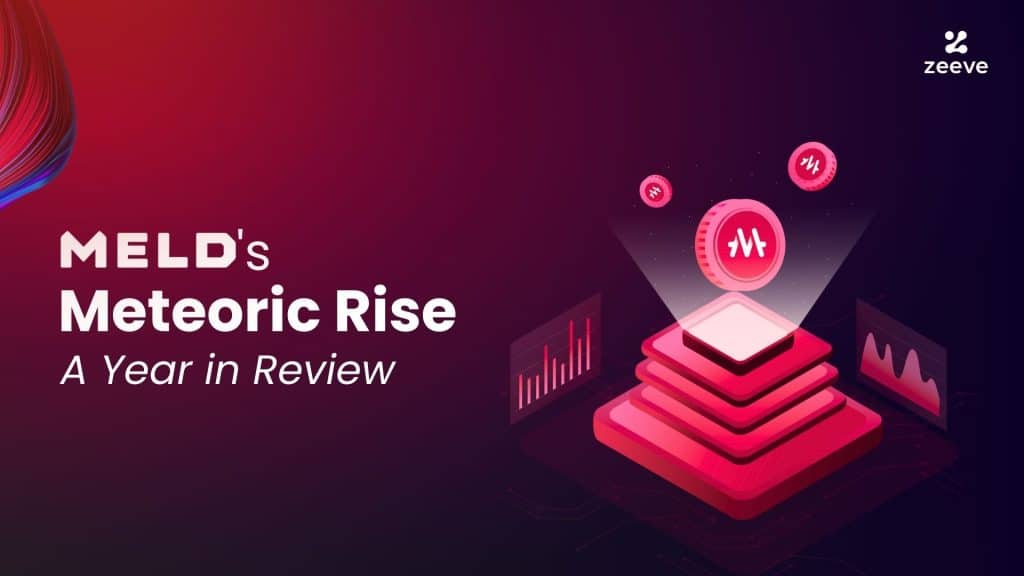In the span of just one year, 60,000+ user wallets were created on MELD! That’s 164 new users per day on average. Not only is the user base growing at this speed, but the validators on its network have grown exponentially from 5 during inception to 30 (a 6x increase), with 27,000,000,000 in gas spent for everyday transactions.
As a new blockchain, these numbers certainly anchor the narrative that MELD’s vision could achieve much in the future.
MELD is an L1 blockchain that bridges the gap between TradeFi and DeFi to help crypto and fiat function harmoniously, not as separate sectors but as a single unified interface, allowing users to enjoy Lending and Borrowing, cross-chain swaps, and much more using the MELDApp in a truly decentralized manner.
MELD by the Numbers: A Techno-Functional Breakdown
| Basis | Value |
| Market Cap | $55.11 M |
| Fully Diluted Valuation | $58.28M |
| Total Staked Amount | 761M ( $10,932,869) |
| MELD Daily Liquidity | $419,405 |
| Key Partnerships | OpenZepplin, ThirdWeb, Go Go Pool, Covalent, Umbrella Network, Supra Oracles |
| No of Token Holders | Wallet Addresses | 56.678k |
| Total Validators | 30 |
Leveraging Avalanche: How L1s Amplify MELD’s Capabilities
Avalanche L1s (Formerly known as Subnets) are customizable appchain-specific blockchains with a collection of validators, enabling distinct and sophisticated control mechanisms for decentralized applications. These L1s (Formerly known as Subnets) excel in access control, making them one of the most advanced and mature options in the appchain space today. They allow for granular management over network interactions, including detailed permissions for who can participate as users, who can act as administrators, and who can run nodes. This capability ensures a high degree of manageability concerning the permissiveness and publicness of the network, which is critical for maintaining security and compliance in decentralized environments.
When launching the MELD chain, it was imperative to establish the MELD ecosystem with heightened security, interoperability, and a unique blockchain architecture. Avalanche L1s (Formerly known as Subnets) perfectly address these needs by allowing MELD to operate within a homogenous blockchain environment without compromising its sovereignty. This is achieved by enabling MELD to define its own rules via custom Virtual Machines (VMs), which handle execution logic and maintain state independently from the main Avalanche chain.
The flexibility to customize its blockchain specifics, such as tokenomics, gas fees, and validator requirements, empowers MELD to meet its operational needs and innovate financial products more efficiently.
Furthermore, Avalanche’s Warp Messaging feature allows MELD’s subnet to maintain easy communication with other L1s (Formerly known as Subnets) and the main chain, thereby supporting efficient cross-chain operations. This capability is crucial for MELD as it seeks to expand its DeFi solutions without the limitations often associated with single blockchain networks. The L1 (Formerly known as Subnets) setup also offers MELD the unique advantage of validator sovereignty. This means MELD can manage its validator network internally and reshuffle as needed, which is particularly important for maintaining network integrity and performance. However, to qualify as a validator for MELD, individuals must also validate the main Avalanche chain and pledge a minimum of 2,000 AVAX.
By utilizing Avalanche L1s (Formerly known as Subnets), MELD enhances its operational capabilities and aligns its user experience with that of traditional financial systems, making it fast, secure, and simple to use. The demand for DeFi products, such as on-chain banking, lending, and borrowing, is rising, and with L1s (Formerly known as Subnets), MELD is well-positioned to meet this demand effectively.
Behind the Scenes: Zeeve Powering The Technical Infrastructure of MELD
The MELD L1 rethinks blockchain design, resulting in near-zero fees, instant transactions, and the ability to leverage native yield on other chains. Complete with a built-in Lending and Borrowing Protocol, MELD leverages a percentage of the yield generated from the Protocol to power the network.
To ensure seamless validator operation, MELD provides its node operators with several infrastructure management options, including Zeeve’s Validator Nodes as a Service. This choice ensures that operators can enjoy an easy onboarding experience coupled with high standards of security, resilience, and a near 100% uptime guarantee. These benefits are supported by Zeeve’s streamlined processes, Enterprise SLA, 24/7 support systems, and compliance with standards such as ISO, SOC2 Type II, and GDPR, which help to lower technical barriers for new participants and enhance the overall security and quality of the network. In addition to validator nodes, Zeeve also offers other critical services, such as RPC and archive node services, to ecosystem participants.
Zeeve’s role extends beyond merely providing node infrastructure; it also includes offering a simplified Avalanche Management Dashboard to MELD. This dashboard enables efficient management of wallet configurations, validator settings, access controls, management of joining requests, and monitoring of node health, among other vital subnet parameters. By facilitating these essential services, Zeeve helps MELD maintain its performance standards and operational robustness as it grows within the Avalanche ecosystem.
What Lies Ahead for MELD and Zeeve
As Zeeve continues to expand its capabilities, we will always ensure we have all the functionality Avalanche adds to L1s (Formerly known as Subnets) . Zeeve will make sure every component of the deployment is standardized and automated. MELD, on the other hand, is building core financial opportunities such as lending and borrowing into its ecosystem. Their multi-tier staking system with liquid and locked tiers that can be freely traded at any time, allowing users to move between pools even when their stakes are locked, adds a layer of flexibility and innovation to the product. Moreover, they are also optimizing the onboarding process to simplify the users’ experience as their momentum continues.
The perfect fusion of Zeeve, which is looking forward to simplifying L1 (Formerly known as Subnets) infra management & monitoring, and MELD, simplifying the DeFi-TradFi bridge, provides a win-win equation for users to collaborate, interoperate, and thrive for the next-gen deFi financial future ahead.
About MELD
MELD unlocks life on-chain. Rethinking blockchain design with native lending and borrowing resulting in instant transactions and near-zero fees. This powers a suite of web3 financial tools and fiat services for builders and users on and off chain.
The MELD ecosystem includes a multi-chain wallet, banking services like fiat to crypto on/off ramps, debit cards, deposit accounts, and native yield, and developers never have to worry about core financial services. You can simply focus on investing and building better products.
MELD always opts for the most yield-rich result for its users, offering liquid staking $MELD and native yield on all L1 coins bridged to the MELD blockchains. Capture this yield by supplying it to the lending and borrowing protocol, which unlocks liquidity and boosts the yield.
@onMELD across all socials + community channels
About Zeeve
Zeeve is the leading appchains and Rollups-as-a-Service provider providing the managed infrastructure for custom L1, L2, and L3 blockchains with all sorts of middleware and integrations.
Zeeve’s robust and reliable Web3 infrastructure platform has won the trust of thousands of web3 startups and enterprises across geographies. With 30,000+ platform users, 40+ large enterprises, and 6000+ nodes, Zeeve is the preferred Blockchain infrastructure provider for all the popular Blockchain protocols.
Contact Zeeve by emailing [email protected] or visiting www.zeeve.io to learn how Zeeve’s web3 infrastructure services can help you kickstart or accelerate your web3 journey.




